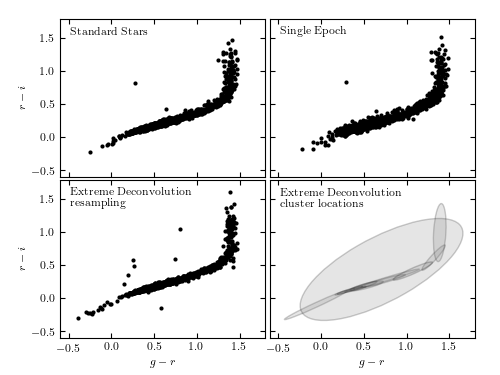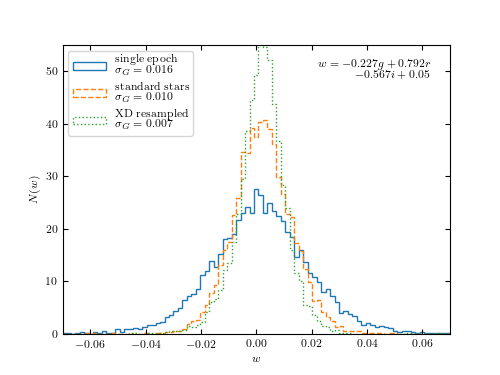Extreme Deconvolution of Stellar Data¶
Figure 6.12
Extreme deconvolution applied to stellar data from SDSS Stripe 82. The top panels compare the color distributions for a high signal-to-noise sample of standard stars (left) with lower signal-to-noise, single epoch, data (right). The middle panels show the results of applying extreme deconvolution to the single epoch data. The bottom panel compares the distributions of a color measured perpendicularly to the locus (the so-called w color is defined following Ivezic et al 2004). The distribution of colors from the extreme deconvolution of the noisy data recovers the tight distribution of the high signal-to-noise data.


number of noisy points: (82003, 2)
number of stacked points: (13377, 2)
size after crossmatch: (12313, 5)
@pickle_results: computing results and saving to 'XD_stellar.pkl'
1: log(L) = 32880
(17 sec)
2: log(L) = 33425
(17 sec)
3: log(L) = 33756
(17 sec)
4: log(L) = 34005
(17 sec)
5: log(L) = 34186
(17 sec)
6: log(L) = 34320
(17 sec)
7: log(L) = 34427
(17 sec)
8: log(L) = 34515
(17 sec)
9: log(L) = 34590
(17 sec)
10: log(L) = 34654
(17 sec)
11: log(L) = 34711
(17 sec)
12: log(L) = 34763
(17 sec)
13: log(L) = 34810
(19 sec)
14: log(L) = 34854
(18 sec)
15: log(L) = 34893
(18 sec)
16: log(L) = 34931
(20 sec)
17: log(L) = 34969
(18 sec)
18: log(L) = 35013
(18 sec)
19: log(L) = 35061
(19 sec)
20: log(L) = 35098
(18 sec)
21: log(L) = 35131
(20 sec)
22: log(L) = 35164
(18 sec)
23: log(L) = 35195
(20 sec)
24: log(L) = 35225
(21 sec)
25: log(L) = 35255
(19 sec)
26: log(L) = 35285
(19 sec)
27: log(L) = 35315
(19 sec)
28: log(L) = 35345
(19 sec)
29: log(L) = 35374
(21 sec)
30: log(L) = 35402
(19 sec)
31: log(L) = 35429
(18 sec)
32: log(L) = 35455
(17 sec)
33: log(L) = 35479
(17 sec)
34: log(L) = 35503
(17 sec)
35: log(L) = 35525
(17 sec)
36: log(L) = 35547
(17 sec)
37: log(L) = 35567
(17 sec)
38: log(L) = 35586
(17 sec)
39: log(L) = 35605
(17 sec)
40: log(L) = 35622
(20 sec)
41: log(L) = 35639
(20 sec)
42: log(L) = 35655
(17 sec)
43: log(L) = 35671
(17 sec)
44: log(L) = 35686
(17 sec)
45: log(L) = 35700
(17 sec)
46: log(L) = 35713
(17 sec)
47: log(L) = 35726
(18 sec)
48: log(L) = 35738
(17 sec)
49: log(L) = 35750
(17 sec)
50: log(L) = 35761
(19 sec)
51: log(L) = 35771
(20 sec)
52: log(L) = 35781
(20 sec)
53: log(L) = 35790
(19 sec)
54: log(L) = 35798
(19 sec)
55: log(L) = 35806
(20 sec)
56: log(L) = 35814
(20 sec)
57: log(L) = 35821
(19 sec)
58: log(L) = 35827
(18 sec)
59: log(L) = 35834
(19 sec)
60: log(L) = 35839
(20 sec)
61: log(L) = 35845
(19 sec)
62: log(L) = 35850
(18 sec)
63: log(L) = 35855
(18 sec)
64: log(L) = 35859
(19 sec)
65: log(L) = 35864
(18 sec)
66: log(L) = 35868
(19 sec)
67: log(L) = 35872
(19 sec)
68: log(L) = 35875
(20 sec)
69: log(L) = 35879
(19 sec)
70: log(L) = 35882
(20 sec)
71: log(L) = 35885
(19 sec)
72: log(L) = 35888
(18 sec)
73: log(L) = 35891
(18 sec)
74: log(L) = 35894
(18 sec)
75: log(L) = 35896
(19 sec)
76: log(L) = 35899
(18 sec)
77: log(L) = 35901
(18 sec)
78: log(L) = 35904
(17 sec)
79: log(L) = 35906
(18 sec)
80: log(L) = 35908
(18 sec)
81: log(L) = 35910
(18 sec)
82: log(L) = 35912
(18 sec)
83: log(L) = 35914
(19 sec)
84: log(L) = 35916
(20 sec)
85: log(L) = 35917
(19 sec)
86: log(L) = 35919
(18 sec)
87: log(L) = 35921
(19 sec)
88: log(L) = 35922
(18 sec)
89: log(L) = 35924
(18 sec)
90: log(L) = 35925
(17 sec)
91: log(L) = 35927
(17 sec)
92: log(L) = 35928
(18 sec)
93: log(L) = 35930
(18 sec)
94: log(L) = 35931
(17 sec)
95: log(L) = 35932
(18 sec)
96: log(L) = 35934
(18 sec)
97: log(L) = 35935
(18 sec)
98: log(L) = 35936
(18 sec)
99: log(L) = 35937
(18 sec)
100: log(L) = 35938
(18 sec)
# Author: Jake VanderPlas
# License: BSD
# The figure produced by this code is published in the textbook
# "Statistics, Data Mining, and Machine Learning in Astronomy" (2013)
# For more information, see http://astroML.github.com
# To report a bug or issue, use the following forum:
# https://groups.google.com/forum/#!forum/astroml-general
from __future__ import print_function, division
import numpy as np
from matplotlib import pyplot as plt
from astroML.density_estimation import XDGMM
from astroML.crossmatch import crossmatch
from astroML.datasets import fetch_sdss_S82standards, fetch_imaging_sample
from astroML.plotting.tools import draw_ellipse
from astroML.utils.decorators import pickle_results
from astroML.stats import sigmaG
#----------------------------------------------------------------------
# This function adjusts matplotlib settings for a uniform feel in the textbook.
# Note that with usetex=True, fonts are rendered with LaTeX. This may
# result in an error if LaTeX is not installed on your system. In that case,
# you can set usetex to False.
if "setup_text_plots" not in globals():
from astroML.plotting import setup_text_plots
setup_text_plots(fontsize=8, usetex=True)
#------------------------------------------------------------
# define u-g-r-i-z extinction from Berry et al, arXiv 1111.4985
# multiply extinction by A_r
extinction_vector = np.array([1.810, 1.400, 1.0, 0.759, 0.561])
#----------------------------------------------------------------------
# Fetch and process the noisy imaging data
data_noisy = fetch_imaging_sample()
# select only stars
data_noisy = data_noisy[data_noisy['type'] == 6]
# Get the extinction-corrected magnitudes for each band
X = np.vstack([data_noisy[f + 'RawPSF'] for f in 'ugriz']).T
Xerr = np.vstack([data_noisy[f + 'psfErr'] for f in 'ugriz']).T
# extinction terms from Berry et al, arXiv 1111.4985
X -= (extinction_vector * data_noisy['rExtSFD'][:, None])
#----------------------------------------------------------------------
# Fetch and process the stacked imaging data
data_stacked = fetch_sdss_S82standards()
# cut to RA, DEC range of imaging sample
RA = data_stacked['RA']
DEC = data_stacked['DEC']
data_stacked = data_stacked[(RA > 0) & (RA < 10) &
(DEC > -1) & (DEC < 1)]
# get stacked magnitudes for each band
Y = np.vstack([data_stacked['mmu_' + f] for f in 'ugriz']).T
Yerr = np.vstack([data_stacked['msig_' + f] for f in 'ugriz']).T
# extinction terms from Berry et al, arXiv 1111.4985
Y -= (extinction_vector * data_stacked['A_r'][:, None])
# quality cuts
g = Y[:, 1]
mask = ((Yerr.max(1) < 0.05) &
(g < 20))
data_stacked = data_stacked[mask]
Y = Y[mask]
Yerr = Yerr[mask]
#----------------------------------------------------------------------
# cross-match
# the imaging sample contains both standard and variable stars. We'll
# perform a cross-match with the standard star catalog and choose objects
# which are common to both.
Xlocs = np.hstack((data_noisy['ra'][:, np.newaxis],
data_noisy['dec'][:, np.newaxis]))
Ylocs = np.hstack((data_stacked['RA'][:, np.newaxis],
data_stacked['DEC'][:, np.newaxis]))
print("number of noisy points: ", Xlocs.shape)
print("number of stacked points:", Ylocs.shape)
# find all points within 0.9 arcsec. This cutoff was selected
# by plotting a histogram of the log(distances).
dist, ind = crossmatch(Xlocs, Ylocs, max_distance=0.9 / 3600)
noisy_mask = (~np.isinf(dist))
stacked_mask = ind[noisy_mask]
# select the data
data_noisy = data_noisy[noisy_mask]
X = X[noisy_mask]
Xerr = Xerr[noisy_mask]
data_stacked = data_stacked[stacked_mask]
Y = Y[stacked_mask]
Yerr = Yerr[stacked_mask]
# double-check that our cross-match succeeded
assert X.shape == Y.shape
print("size after crossmatch:", X.shape)
#----------------------------------------------------------------------
# perform extreme deconvolution on the noisy sample
# first define mixing matrix W
W = np.array([[0, 1, 0, 0, 0], # g magnitude
[1, -1, 0, 0, 0], # u-g color
[0, 1, -1, 0, 0], # g-r color
[0, 0, 1, -1, 0], # r-i color
[0, 0, 0, 1, -1]]) # i-z color
X = np.dot(X, W.T)
Y = np.dot(Y, W.T)
# compute error covariance from mixing matrix
Xcov = np.zeros(Xerr.shape + Xerr.shape[-1:])
Xcov[:, range(Xerr.shape[1]), range(Xerr.shape[1])] = Xerr ** 2
# each covariance C = WCW^T
# best way to do this is with a tensor dot-product
Xcov = np.tensordot(np.dot(Xcov, W.T), W, (-2, -1))
#----------------------------------------------------------------------
# This is a long calculation: save results to file
@pickle_results("XD_stellar.pkl")
def compute_XD(n_clusters=12, rseed=0, max_iter=100, verbose=True):
np.random.seed(rseed)
clf = XDGMM(n_clusters, max_iter=max_iter, tol=1E-5, verbose=verbose)
clf.fit(X, Xcov)
return clf
clf = compute_XD(12)
#------------------------------------------------------------
# Fit and sample from the underlying distribution
np.random.seed(42)
X_sample = clf.sample(X.shape[0])
#------------------------------------------------------------
# plot the results
fig = plt.figure(figsize=(5, 3.75))
fig.subplots_adjust(left=0.12, right=0.95,
bottom=0.1, top=0.95,
wspace=0.02, hspace=0.02)
# only plot 1/10 of the stars for clarity
ax1 = fig.add_subplot(221)
ax1.scatter(Y[::10, 2], Y[::10, 3], s=9, lw=0, c='k')
ax2 = fig.add_subplot(222)
ax2.scatter(X[::10, 2], X[::10, 3], s=9, lw=0, c='k')
ax3 = fig.add_subplot(223)
ax3.scatter(X_sample[::10, 2], X_sample[::10, 3], s=9, lw=0, c='k')
ax4 = fig.add_subplot(224)
for i in range(clf.n_components):
draw_ellipse(clf.mu[i, 2:4], clf.V[i, 2:4, 2:4], scales=[2],
ec='k', fc='gray', alpha=0.2, ax=ax4)
titles = ["Standard Stars", "Single Epoch",
"Extreme Deconvolution\n resampling",
"Extreme Deconvolution\n cluster locations"]
ax = [ax1, ax2, ax3, ax4]
for i in range(4):
ax[i].set_xlim(-0.6, 1.8)
ax[i].set_ylim(-0.6, 1.8)
ax[i].xaxis.set_major_locator(plt.MultipleLocator(0.5))
ax[i].yaxis.set_major_locator(plt.MultipleLocator(0.5))
ax[i].text(0.05, 0.95, titles[i],
ha='left', va='top', transform=ax[i].transAxes)
if i in (0, 1):
ax[i].xaxis.set_major_formatter(plt.NullFormatter())
else:
ax[i].set_xlabel('$g-r$')
if i in (1, 3):
ax[i].yaxis.set_major_formatter(plt.NullFormatter())
else:
ax[i].set_ylabel('$r-i$')
#------------------------------------------------------------
# Second figure: the width of the locus
fig = plt.figure(figsize=(5, 3.75))
ax = fig.add_subplot(111)
labels = ['single epoch', 'standard stars', 'XD resampled']
linestyles = ['solid', 'dashed', 'dotted']
for data, label, ls in zip((X, Y, X_sample), labels, linestyles):
g = data[:, 0]
gr = data[:, 2]
ri = data[:, 3]
r = g - gr
i = r - ri
mask = (gr > 0.3) & (gr < 1.0)
g = g[mask]
r = r[mask]
i = i[mask]
w = -0.227 * g + 0.792 * r - 0.567 * i + 0.05
sigma = sigmaG(w)
ax.hist(w, bins=np.linspace(-0.08, 0.08, 100), linestyle=ls,
histtype='step', label=label + '\n\t' + r'$\sigma_G=%.3f$' % sigma,
density=True)
ax.legend(loc=2)
ax.text(0.95, 0.95, '$w = -0.227g + 0.792r$\n$ - 0.567i + 0.05$',
transform=ax.transAxes, ha='right', va='top')
ax.set_xlim(-0.07, 0.07)
ax.set_ylim(0, 55)
ax.set_xlabel('$w$')
ax.set_ylabel('$N(w)$')
plt.show()
